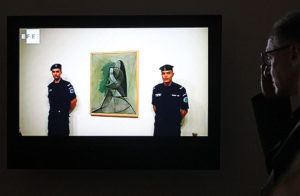Meet the man who brought Picasso to Palestine

Picasso in Ramallah 2011
writes in Al-Monitor:
Why shouldn’t Picasso go to Palestine?” Khaled Hourani, artist, curator and artistic director of a young gallery in Ramallah, asked himself a decade ago, as he was touring the Van Abbemuseum in the Dutch city of Eindhoven.
Why not indeed? The works of Pablo Picasso, the prolific Catalan painter, are displayed all around the world, including Palestine’s neighbors. But Ramallah, cut off from the rest of the world with checkpoints and sheer poverty, was no ordinary spot. Even if the political and diplomatic difficulties could be put aside, there was no museum in Palestine that would secure the physical conditions — security, humidity and funds required for insurance — for the painting Hourani had in mind — “Buste de Femme,” an oil painting created in 1943 worth $7.1 million.
Yet the determined young man succeeded sooner than most people expected, including the administrators of the Van Abbemuseum. In 2011, “Buste de Femme” arrived in Ramallah, in an event that put its mark on the 2010s in the Middle East art scene.
Today, as we list the top cultural global events of the last decade, Hourani’s “Picasso in Palestine” exhibition and a video of its backdrop ranks as #52 in Artnet News in the 100 works of art that define the decade. There are only three other projects from the Middle East, including the films “Cabaret Crusades” (2010-15) by Egyptian artist Wael Shawky, as #16.
“Artist and curator Khaled Hourani’s elaborate efforts to get ‘Buste de Femme,’ a 1943 work by Picasso in the collection of the Van Abbemuseum in Eindhoven, to be seen at Ramallah’s International Academy of Art, has become, among other things, a widely seen documentary,” said the article. “But really the entire project was consciously designed as a kind of critical gesture, a way to use the value of art and the difficulty of transporting it as a way to throw into relief the absurdities of life under occupation.”
